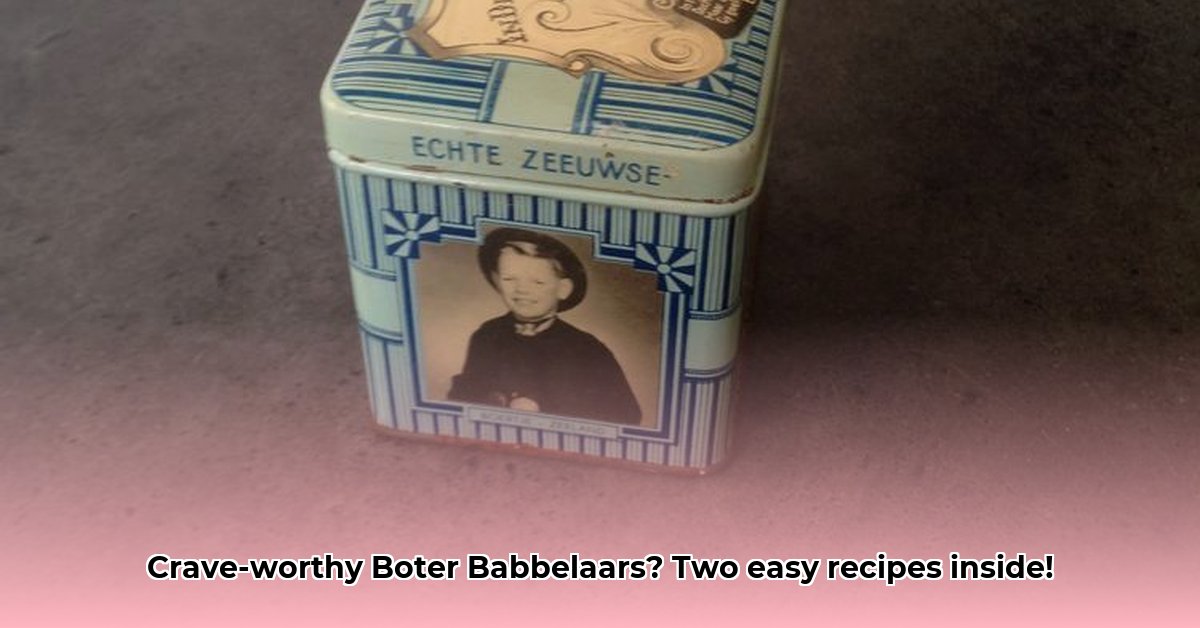
Right, so you're keen to make some Zeeuwse Boterbabbelaars? These little Dutch butter biscuits are lekker – all chewy and buttery, a real treat! But making them can seem a bit tricky. This article shows you exactly how, comparing two different recipes (Allerhande and Food.com) so you can find your perfect method. We'll cover the important bits, like getting that perfect texture, and share tips to avoid any baking disasters. Whether you're a kombuis-koningin or just starting out, this guide will help you make these awesome little treats. Let's bake!
Boter Babbelaars: Two Delicious Approaches to a Classic Treat
Hey there, fellow bakers! Let's get our hands sticky and dive into the delightful world of Boter Babbelaars – those gloriously chewy, buttery bites from Zeeland. Think melt-in-your-mouth texture, subtle sweetness, and a flavour that’s pure nostalgic bliss. We'll explore two popular recipes, comparing their methods and results. Get ready to be amazed!
Cracking the "String Stage" Code
Before we start, let's talk about the crucial "string stage" (the point where a drop of your simmering mixture, tested in icy water, forms a thin, stretchy thread). This signals your mixture is perfectly cooked, regardless of the recipe. Don't rush this; it's key to perfect texture. Isn't it fascinating how a simple test can make such a difference?
Recipe 1: The Allerhande Approach – Easy Peasy!
This method is super simple, perfect for beginners or those wanting a quicker bake.
Ingredients: (Exact quantities are in the full Allerhande recipe – you'll need butter, sugar, and vinegar.)
Instructions:
Melt and Mix: Gently melt butter in a saucepan. Stir in sugar and vinegar until smooth. Use a heatproof spatula.
Simmer to Perfection: Simmer on low heat, stirring constantly. Aim for the "string stage" – test a drop in cold water. Constant stirring prevents burning, a common problem. Did you know that even heat distribution is crucial?
Spread and Cool: Pour the mixture onto a buttered baking sheet. Spread it thinly (about as thick as a crispbread).
The Waiting Game: Let it cool completely. This is vital for the texture. Don't touch it until firm (this might take a couple of hours). Patience, my friend, patience!
Slice and Serve: Once cool and firm, cut into squares or diamonds. A sharp knife helps for neat edges.
Pros: Simple, ideal for beginners, minimal effort, quick cleanup.
Cons: Texture might be slightly more brittle than other methods. Prioritizes ease.
Recipe 2: The Food.com Method – A Chewy Challenge!
The Food.com method is more hands-on, requiring more skill and attention. But the reward? Extra chewy, intensely flavoured Boter Babbelaars!
Ingredients: (Specific quantities are in the Food.com recipe; you'll need butter, sugar, and vinegar.)
Instructions:
Simmering Success: Follow steps 1 and 2 from the Allerhande method, reaching the "string stage." Constant stirring is key to prevent burning!
Active Cooling: Immediately work the hot mixture with a buttered knife or spatula. Fold, push, and continually work it as it cools. This manipulation creates the chewy texture.
Rope and Cut: Once cool enough to handle (but still slightly warm), shape into a long rope. Cut into bite-sized pieces.
Pros: Creates exceptionally chewy Boter Babbelaars with intense flavour. Rewarding for enthusiastic bakers.
Cons: Requires more time, active participation, and baking expertise. Not for the faint of heart, but the extra chewy results are worth it!
Comparing the Contenders: Texture, Effort, and Skill
Here's a summary:
| Feature | Allerhande Method | Food.com Method |
|---|---|---|
| Texture | Brittle, less chewy | Extra chewy, intense flavour |
| Skill Level | Beginner-friendly | Intermediate |
| Effort Level | Low | Moderate to high |
| Cooling Method | Passive, spreading | Active, continuous working |
Troubleshooting – Avoiding Baking Blunders
Even experienced bakers face challenges. Here are a few tips:
Burning Prevention: Low and slow heat, plus constant, gentle stirring, are crucial. Don’t leave it unattended.
Texture Consistency: Ensure even cooling. For the Food.com method, continuous working is key for a uniform texture.
The Verdict – Which Method Reigns Supreme?
The best method depends on your baking experience and desired outcome. If you're a beginner or want an easy recipe, the Allerhande method is perfect. But if you crave extra-chewy, intensely flavoured treats and enjoy a more hands-on experience, the Food.com method is worth the effort. Remember, baking is an adventure! Experiment, have fun, and enjoy your delicious Boter Babbelaars!
How to Achieve the Perfect Texture in Zeeuwse Boterbabbelaars
Key Takeaways:
- Two main methods exist for making Zeeuwse boterbabbelaars, differing in cooling and shaping.
- Both use similar ingredients: butter, sugar, syrup/molasses.
- Success lies in achieving the right consistency and working quickly during the cooling phase.
- Understanding the nuances of each method helps tailor your approach to your skill and desired texture.